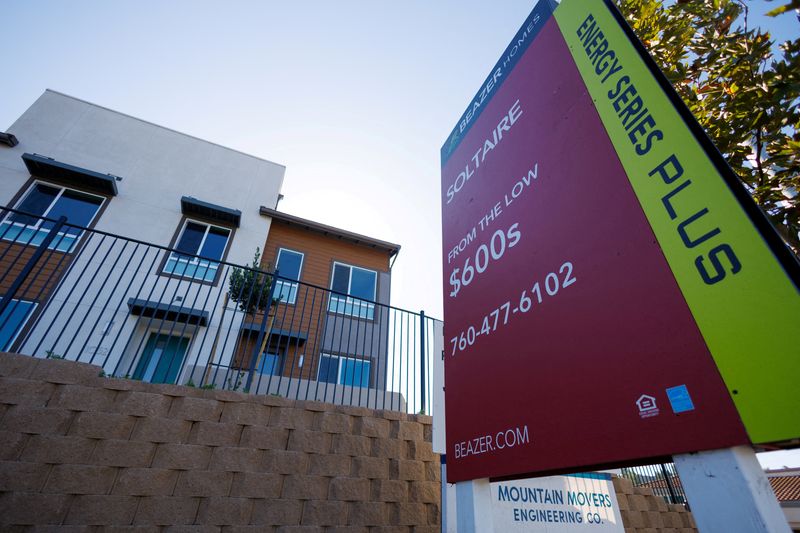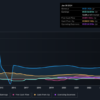
By Ann Saphir
(Reuters) – The interest rate for the most popular U.S. home loan plunged last week to its lowest level in 15 months, after the Federal Reserve signaled it could start cutting its policy rate in September and a downshift in the job market bolstered financial market bets the reductions in borrowing costs would be big.
The average contract rate on a 30-year fixed-rate mortgage dropped 27 basis points in the week ended Aug. 2, to 6.55%, the Mortgage Bankers Association said on Wednesday. That was the lowest rate since May 2023 and the sharpest drop in two years.
The decline gives potential homebuyers some long-hoped-for relief in what has become an increasingly unaffordable housing market in recent years, as home prices and borrowing costs both rose.
That unaffordability was also on display on Wednesday in July’s housing sentiment index from Fannie Mae, the government-sponsored mortgage finance company. Only 17% of respondents said it was a good time to buy a home, down from 19% in June, Fannie Mae said.
Moreover, 35% said they would rent their next residence – rather than buy it – the highest share since 2011.
“Right now, it’s difficult to tell if this reflects simple buyer fatigue or a greater sense of disenchantment with the market, but we think it could have important implications should the trend continue,” Doug Duncan, chief economist at Fannie Mae, said in a statement.
REFINANCE WAVE
The drop in interest rates also gives some people who bought homes when rates were higher the option to refinance and reduce payments. The MBA 30-year average rate topped out at 7.9% last October.
Refinancing applications rose sharply to the highest level in two years, the MBA said on Wednesday. That helped lift the refinance share of overall loan application volumes to 41.7% – the highest level since the week of the Fed’s first rate hike in March 2022.
But purchase activity edged up less than 1%, constrained by a low inventory of homes for sale that has pushed up prices.
The Fed, whose aggressive inflation-fighting rate-hike campaign in 2022 and 2023 drove borrowing costs to their highest levels in decades, signaled last week that cooling price pressures and a slowing labor market mean a policy rate cut could be on the table as soon as next month. The U.S. central bank has kept its policy rate in the 5.25%-5.50% range for more than a year.
Two days after the Fed’s last policy meeting, the Labor Department’s monthly jobs report showed that the U.S. unemployment rate had jumped to 4.3% in July and hiring had slowed, raising fears a recession is imminent or perhaps even underway.
The fears set off a slide in equities that reverberated in global markets into Monday, before stocks recovered somewhat on Tuesday. Major U.S. stock indices were trading higher again on Wednesday.
Last week’s labor market data also triggered a rally in U.S. Treasuries, lowering their yields – which move inversely to bond prices – and pulling closely linked mortgage rates down along with them, a silver lining for millions of U.S. households on the hunt for new homes, cheaper housing, or both.
RATE CUTS COMING
While the Fed left rates steady at its July meeting, its post-meeting policy statement showed it was now just as focused on the health of the labor market as on bringing down inflation.
That shift in communication, San Francisco Fed President Mary Daly said on Monday, has translated to lower mortgage rates as investors anticipate the central bank’s next move.
“You already see policy working, even before we cut the rate,” she said.
Interest rate futures now reflect bets the Fed will cut its policy rate by a total of a full percentage point by the end of this year, starting with a reduction of half a percentage point next month.
More than 4 million mortgages originated since 2022 have interest rates of 6.5% or higher, according to Intercontinental Exchange’s ICE Mortgage Monitor.
But more than six in 10 mortgages have rates below 4%, according to data from Freddie Mac, the government-sponsored mortgage giant. That suggests that for a large fraction of homeowners mortgage rates would need to drop far more to make the cost of refinancing worthwhile, or to entice them to buy a new home and put their current one on the market.
(Reporting by Ann Saphir; Additional reporting by Dan Burns; Editing by Leslie Adler and Paul Simao)
EMEA Tribune is not involved in this news article, it is taken from our partners and or from the News Agencies. Copyright and Credit go to the News Agencies, email news@emeatribune.com Follow our WhatsApp verified Channel





